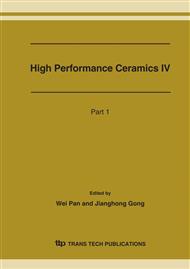p.1615
p.1618
p.1622
p.1625
p.1628
p.1632
p.1635
p.1638
p.1642
Improvement of Anti-Washout Performance of Calcium Phosphate Cement Using Modified Starch
Abstract:
Calcium phosphate cements (CPCs) are well-known orthopedic materials for filling bone. However, CPC pastes tend to disintegrate immediately when contacting with blood or other aqueous (body) fluids, which is a main limitation of its clinical applications in bone repairing, reconstruction and augmentation. To improve the anti-washout performance of CPC, modified starches such as pre-gelatinized starch, etherified starch, and esterified starch were added to the liquid phase of CPC in this work. CPC with good anti-washout performance was prepared and the effects of the modified starches on the properties of CPC were investigated. The results showed that the CPC with the modified starches were more stable in simulated body fluid than that without modified starch, especially the CPC with the etherified starch (II). X-ray diffraction analysis revealed that the modified starches did not inhibit CPC components from converting to hydroxyapatite. Furthermore, the anti-washout mechanism of the modified starches in CPC was discussed. It is concluded that the addition of the modified starches such as pre-gelatinized starch, etherified starch, and esterified starch to CPC can improve its anti-washout performance and should be of value in clinical surgery where the cement is exposed to blood.
Info:
Periodical:
Pages:
1628-1631
Citation:
Online since:
April 2007
Authors:
Price:
Сopyright:
© 2007 Trans Tech Publications Ltd. All Rights Reserved
Share:
Citation:


